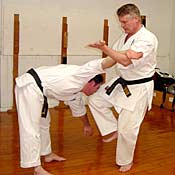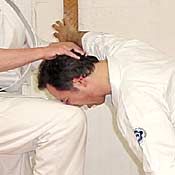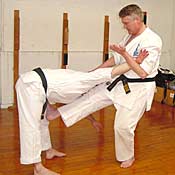Escaping The Wrist Grab
Part 3 – The Two Arm Wrist Grab
by Christopher Caile

Editor’s Note: This is the third in a series of articles on escaping from wrist grabs. Part 1 – From The Same Side discussed several self-defense options against a same side grab. Part 2 – From The Opposite Side discussed a wrist grabbed by the opponent’s opposite arm. Part 4 will discuss escaping from a reverse wrist grab.
Historically wrist grabs were often used to stopping an opponent from using of a weapon. For this reason older style Japanese jujutsu system were replete with various types of wrist pins, grabs and other manipulations. Today, however, wrist grabs are most often used by one person to control or pull another person.
This article will illustrate several self-defense techniques useful in escaping the two arm wrist grab, as seen above. The advantages and disadvantages of each are also discussed.
Throughout this series we have stressed the need for any self-defense technique to be effective, easily applied and useful for a weaker person against a stronger one. (1)
There should be a “continuum of force” in any technique — basic release methods should start with just a basic release and progress through being able to render the assailant unconscious, incapacitated or immobilized.
Here we are examining the two arm wrist grab. For the person attacked, this attack can be scary, but it is fatally flawed — it ties up the two hands and arms of the attacker and focuses his attention on the grabbed wrist. The defender, however, has a free hand, elbow, head, two knees and feet available as weapons.
Preliminary Techniques


Be very careful with this type kick since it can easily injure or tear the ligaments of the knee and/or the knee cap. Another simple distraction includes a backhand slap (keeping the fingers loose) of the assailant’s testicles (if male) with the back of the free hand.
These distraction or stunning techniques alone will often end the attack. While in Okinawa a few years ago, I was reminded by several well known masters that these type distraction or stunning techniques could be added to any technique. And if we think of kata and the natural position and upright stance from which they begin, it is easy to image how these techniques could be used as an initial response to a variety of grabbing attacks. (2) (In the following two self-defense techniques shown it is assumed that the defender could initially use any of the initial techniques shown or illustrated above.)
Self-Defense Escapes




The first basic self-defense sequence illustrated here is similar to those illustrated in the first to articles in this series — to simply to raise your grabbed fist to the inside of the two grabbing arms and while grabbing your own fist with your other arm to pull back, using your weight against the attacker’s thumbs — the weak link in most wrist grabs.
The advantages of this technique are that it is quick and simple. The disadvantage is that if the defender is significantly weaker than the attacker, the technique often just won’t work. If the attacker holds the grabbed arm down, not allowing it to angle upward so the fist can rise (be pulled up) between the grabbing forearms, it is significantly more difficult to do this technique — it is harder to grab your own fist, and more strength is require to pull free. Another drawback is that even if the defender breaks the hold, he or she is still in front of the assailant, who has not been controlled. Thus this technique while widely taught, is problematic at best — a short term solution, if it works at all.
A second approach, which I much prefer, closely parallels that used against the other wrist grabs as well — a technique drawn from the karate kata Saiha.




The attacker grabs with both hands (not shown) as in the first sequence. Here the initial first response is not directly resist, but to drop while moving forward – dropping your weight along with your elbow. Your weight and not muscle strength, turns your forearm in the attacker’s grip so you hand rises above the level of the attacker’s forearm. You can then (seen from opposite side) hook your fingers over the attacker’s arm (photo 3) to create a position of leverage. (3)
As you continue to move forward (4) into a side facing horse stance, the leverage of your arm position with the weight behind it will break the grip on your arms — almost without any muscle strength. If you were just seeking to break free this would be the end. But if you are countering a serious attack, add a nose strike with the palm of the opposite hand, and then grab the hair to pull the head down into a backfist and your drop backward into a wider horse stance (as seen). (5)
This is where the fun begins. If you follow saiha kata there is a lot more to follow. And it’s devastating.
After completing the last technique, and if circumstances dictate that further action against the assailant is necessary, saiha kata demonstrates an effective follow-up technique (a technique that can also be used in a variety of circumstances). (6) The defendant who is standing sideways in a horse stance, has grabbed the opponent’s hair with one hand and pulled the head down as he or she executes a backhand strike to the face with the opposite hand.
 In saiha the defender moves at an angle to the left (different styles use slightly different leg movements in this situation) while the right lifted hand and lower left hand cross each other going in opposite directions. When most people examine kata they look at beginning and end movements, while here it is the direction, angle and movement pattern that is important.
In saiha the defender moves at an angle to the left (different styles use slightly different leg movements in this situation) while the right lifted hand and lower left hand cross each other going in opposite directions. When most people examine kata they look at beginning and end movements, while here it is the direction, angle and movement pattern that is important.
In the kata the right hand is initially lifted (moved upward from the backhand strike) in preparation to its being moved downward. At the same time the left hand starts to move downward (from the hair grab). At the point they begin to cross in the kata is where the action is.
As illustrated above the left hand moves down to brace the side of the head as the elbow of the right arm slams upward into the neck and jaw of the assailant (backed by the body weight that is shifting in the same direction) which if done with power can almost lift the opponent upward. It will probably also knock him or her out.
 The raised right hand (as in the kata) begins to circle downward as the body move to the left — the right palm guiding the opponent’s head to the left and down to meet a right upward knee strike. Be very careful when practicing this technique because the whipping head action created can easily get out of control.
The raised right hand (as in the kata) begins to circle downward as the body move to the left — the right palm guiding the opponent’s head to the left and down to meet a right upward knee strike. Be very careful when practicing this technique because the whipping head action created can easily get out of control.
 A close-up of the knee strike is also shown from the opposite side. In this technique the left hand has also circled inside and out and captures the opponent’s wrist in the closed inside crease of the elbow. This technique is relatively easy to accomplish because it begins with an already stunned opponent who is immediately hit again with the elbow strike to an area of the neck and chin. Then if the head is moved off its base (the body) and to the side, relatively all strength is lost since the opponent is off-balance.
A close-up of the knee strike is also shown from the opposite side. In this technique the left hand has also circled inside and out and captures the opponent’s wrist in the closed inside crease of the elbow. This technique is relatively easy to accomplish because it begins with an already stunned opponent who is immediately hit again with the elbow strike to an area of the neck and chin. Then if the head is moved off its base (the body) and to the side, relatively all strength is lost since the opponent is off-balance.
 The final movement of this sequence (and kata) is a right front kick that follows immediately from the knee kick. Here it is a kick with the sole of the foot to the inside of the opponent’s knee (same as demonstrated above) which can dislocate the knee and/or the knee cap. Other options include a standard groin kick, or a toe kick (a favorite in old Okinawan karate) up under the groin/testicles. If something should misfire in the above knee kick and leg/groin kick, the left hand is so positioned that the defender can at any time rotate his right side to the back, the right hand grabbing the attacker’s wrist as the left effects an elbow lock.
The final movement of this sequence (and kata) is a right front kick that follows immediately from the knee kick. Here it is a kick with the sole of the foot to the inside of the opponent’s knee (same as demonstrated above) which can dislocate the knee and/or the knee cap. Other options include a standard groin kick, or a toe kick (a favorite in old Okinawan karate) up under the groin/testicles. If something should misfire in the above knee kick and leg/groin kick, the left hand is so positioned that the defender can at any time rotate his right side to the back, the right hand grabbing the attacker’s wrist as the left effects an elbow lock.
The advantages of this technique are that it takes virtually no strength (the initial release), it controls the opponent and can progress through various levels of force. In addition, virtually the same technique can be used to release from other wrist grabs, a head lock, and several other attacks as well. The disadvantage is that it is somewhat more complicated than the first technique illustrated.
A third self-defense option to the double arm grab closely parallels a similar technique found in part two of this series — a wrist lock (nikyo) technique. This type of technique, although performed somewhat differently, is found in aikido, daito-ryu, aikijujutsu, many karate and kung fu systems, in Chinese chin na and most jujutsu systems. Here an aikido version is demonstrated.



To make this technique work easily, it is essential to distract and off balance the opponent. Here a face slap is used combined with a movement of the body to the side and back which pulls the opponent forward and to the side. Attention and strength are diverted. As you make this move, place your left hand on top of the opponent’s right wrist and circle your right hand up and to the outside of the opponent’s right forearm. For more details of this move refer to part two of this series.
Your right hand continues to circle until it is over the opponent’s wrist where it is placed palm down on top (as illustrated). An alternative, used in many systems (not shown), is to place the little finder side of the palm (the hand in a hand-sword, or shuto position) on top of the opponent’s wrist. Whatever the hand position, however, the operational principle is to rotate your right hand (not pressing down) around the opponent’s wrist back toward your own center.
If done correctly the opponent will immediately feel great pain and drop to his knees. Back up and pull him forward as you keep him in this position for control.
The advantage of this technique is that it is relatively simple to master, takes little strength and controls the assailant. The disadvantage is that it requires practice and correct form in order to assure its effectiveness, especially against much stronger and larger opponents. And, if it fails, the opponent still has a grip on you.
Footnotes:
(1) When teaching karate and self-defense at the State University of New York at Buffalo (SUNY), we did considerable research on the effectiveness of various self-defense techniques. Surprisingly, we found that many self-defense techniques widely taught just did not work. The defenders if significantly smaller and weaker, could not escape determined assailants who resisted, or the techniques themselves were difficult to perform.
(2) Several of the old Okinawan techniques of this type include the testicle slap and eye techniques discussed above as well as a spit in the face of an opponent.
(3) The action of moving in three directions at once is confusing to the defender. He expects a resistant pull back, but instead you move in and drop. The move of the forearm is secondary to his expectations, lost within the total movement and difficult to oppose with only thumb strength.
(4) When performing saiha kata the defender moves in further so the feet come together (in the above example the feet are kept somewhat separated in a small horse stance) with the initial elbow technique. This too can be effective, since the elbow once free of the two arm grab can turn into an elbow smash against the chest or side of the face. The technique shown here, however, is modified. The reason are two. First, it is desirable to isolate the escape so it can be easily practiced and secondly because with a follow-up elbow strike to the head, the head is often propelled so far backward that a follow-up hair grab and backhand strike cannot be executed.
(5) As you step into the opponent with your elbow, the leverage forces his elbows outward and his body forward into the palm strike to the face (if this elected). This drives the head backward, immediately to be grabbed and pulled forward – creating a damaging whip-like effect if done quickly and powerfully.
An alternative in this two arm wrist grab self-defense sequence drawn from the kata saiha, as in others illustrated in this article series, is to grab the opponent’s left arm (after the release) while doing a backhand strike into the face (show in previous articles. If this alternative is used you continue your body motion forward into the attack rather than dropping back into horse stance (as illustrated above). A follow up in this situation could include an arm bar. Either option is viable, and both should be practiced since you can never be totally sure how an opponent will react to your initial technique.
(6) I classify this as a head-manipulation technique, one of many that can be found within karate kata. The principle behind any such technique is to move the head (a small-light object) off its center (the body) — backward, forward or to the side — to off-balance an opponent. This type technique is often associated with aikido (most often called a kokyu-nage, or breath throw), kali and to a lesser extend many jujutsu systems.

About the Author Christopher Caile

Christopher Caile
Christopher Caile is the Founder and Editor-In-Chief of FightingArts.com. He has been a student of the martial arts for over 65 years.
He first started in judo while in college. Then he added karate as a student of Phil Koeppel in 1959 studying Kempo and Wado-Ryu karate. He later added Shotokan Karate where he was promoted to brown belt and taught beginner classes. In 1960 while living in Finland, Caile introduced karate to that country and placed fourth in that nation’s first national judo tournament.
Wanting to further his karate studies, Caile then hitch hiked from Finland to Japan traveling through Scandinavia, Europe, North Africa, the Middle East and South and Southeast Asia — living on 25 cents a day and often sleeping outside.
Arriving in Japan (1962), Caile was introduced to Mas Oyama and his fledgling full contact Kyokushinkai Karate by Donn Draeger, the famous martial artist and historian. Donn also housed him with several other senior international judo practitioners. Donn became Caile’s martial arts mentor, coaching him in judo and introducing him to Shinto Muso-ryu under Takaji Shimizu.
Caile studied at Oyama’s honbu dojo and also at Kenji Kurosaki’s second Tokyo Kyokushinkai dojo. In his first day in class Oyama asked Caile to teach English to his chief instructor, Tadashi Nakamura. They have been friends ever since. Caile also participated in Oyama’s masterwork book, “This Is Karate.”
Caile left Japan with his black belt and designation as Branch Chief, the first in the US to have had extensive training in Japan directly under Oyama Sensei. As such, Oyama Sensei asked him to be his representative on visits to his US dojos to report on their status.
A little over a year later, Nakamura, Kusosaki and Akio Fujihira won an epic David vs. Goliath challenge match against Thailand’s professional Muay Thai Boxers in Bangkok, Thailand, thrusting Kyolushinkai and Nakamura into national prominence.
Back in the US Caile taught Kyokushinkai karate in Peoria, Il while in college and later in Washington, DC. while in graduate school. Durimg this time Shihan Nakamura had moved to New York City to head Kyokushinkai’s North American Operation.
In 1976 when Kaicho Tadashi Nakamura formed the World Seido Karate organization, Caile followed. Living then in Buffalo, NY, Caile taught Seido karate and self-defense at the State University of New York at Buffalo (SUNY Buffalo) for over 15 years where he also frequently lectured on martial arts and Zen in courses on Japanese culture.
Caile moved to New York City in 1999 to marry Jackie Veit. He is now an 8th degree black belt, Hanshi, training in Seido Karate’s Westchester, NY Johshin Honzan (Spiritual Center) dojo. In Seido Caile is known for his teaching of and seminars on kata applications. He also produced a 14 segment video series on Pinan kata Bunkai currently available to Seido members.
Caile is also a long-time student and Shihan in Aikido. He studied in Buffalo, under Mike Hawley Shihan, and then under Wadokai Aikido’s founder, the late Roy Suenaka (uchi deshi under Morihei Ueshiba, founder of Aikido and was Shihan under Tohei Sensei). In karate, Suenaka (8thdan) was also an in-house student of the Okinawan karate master Hohan Soken.
Having moved to New York City, Caile in 2000 founded this martial arts educational website, FightingArts.com. Twenty-five years later, in 2025, it underwent a major update and revision.
For FightingArts.com and other publications Caile wrote hundreds of articles on karate, martial arts, Japanese art, Chinese Medicine and edited a book on Zen. He also developed relationships with a cross section of leading martial arts teachers. Over the last four decades he has conducted extensive private research into karate and martial arts including private translations of the once secret Okinawan hand copied and passed on Kung Fu book, the Bubishi, as well as an early karate book by the karate master Kenwa Mabuni. He periodically returns to Japan and Okinawa to continue his studies and participate Seido karate events. In Tokyo he practiced (with Roy Suenaka Sensei) in a variety of aikido organizations with their founders – including private interviews and practices at the Aiki-kai Aikido Honbu dojo with the son and grandson of aikido’s founder, Doshu (headmaster) Kisshomaru (an old uchi-deshi friend) and his son, Moriteru Ueshiba and in Iwama with Morihiro Saito. On Okinawa he studied Goju Ryu karate under Eiichi Miyazato, 10th dan founder of Naha’s Jundokan, and also with Yoshitaka Taira (who later formed his own organization, who specialized in kata Bunkai. While there Caile also trained with Hohan Soken’s senior student, Master Fusei Kise, 10 dan as well as with the grandson of the legendary karate master Anko Itosu.
Caile’s other martial arts experience includes: Diato-ryu Aikijujitsu and Kenjitsu, kobudo, boxing, Muay Thai, MMA, Kali (empty hand, knife and bolo), study of old Okinawan Shoran-ryu & Tomari body mechanics, study of old Okinawan kata under Richard Kim, study of close quarter defense and combat, including knife and gun defenses, Kyusho Jitsu and several Chinese fighting arts including 8 Star Praying Mantis, Pak Mei (White Eyebrow), and a private family system of Kung Fu.
Caile is also a student of Zen as well as a long-term student of one branch of Traditional Chinese Medicine, Chi Kung (Qigong). As one of two senior disciples of Chi Kung master Dr. Shen (M.D., Ph.D.) Caile was certified to teach and practice. This led to Caile’s founding of the The Chi Kung Healing Institute on Grand Island, NY. In Western NY, he also frequently held Chi Kung seminars, including at SUNY Buffalo and at the famous Chautauqua Institution in Chautauqua, NY. His articles on Chi Kung also appeared in the Holistic Health Journal and in several books on alternative medicine.
Caile holds a BA in International Studies from Bradley University and MA in International Relations with a specialty in South and Southeast Asia from American University in Washington, D.C. While in Buffalo, NY he also studied digital and analog electronics.
In his professional life Caile also worked in public relations and as a newspaper reporter and photographer. Earlier he worked in the field of telecommunications including Managing a Buffalo, NY sales and service branch for ITT. He then founded his own private telephone company. This was followed by creation of an electrical engineering company that designed and patented his concept for a new type of low-cost small business telephone system (which was eventually sold to Bell South). The company also did contract work for Kodak and the US space program. Simultaneously Caile designed and manufactured a unique break-apart portable pontoon boat.
Most recently Caile co-founded an internet software company. Its products include software suites with AI capability for control and management of streaming media, such as video and music, an all-in-one book publishing software product for hardcover, eBook and audio book creation and security software for buildings and government use.
For more details about Christopher Caile’s martial arts, work experience and life profile, see the About section in the footer of this site.
Search for more articles by this author:






